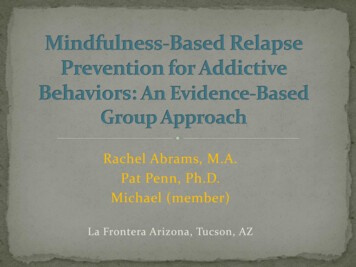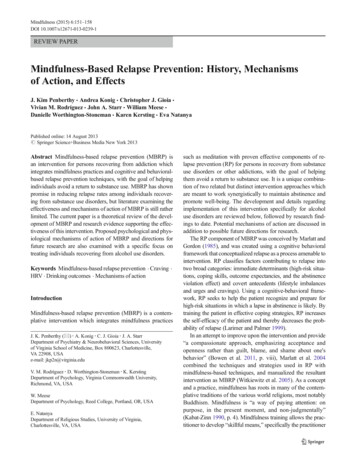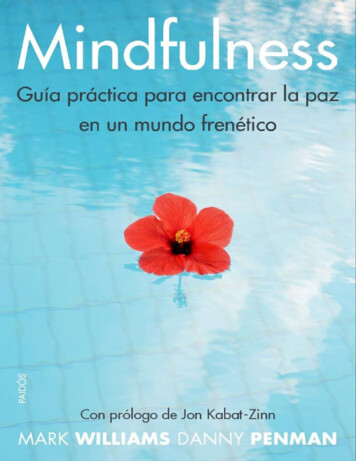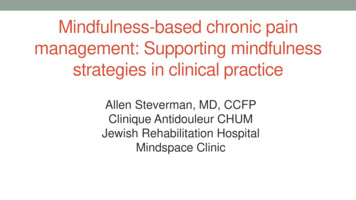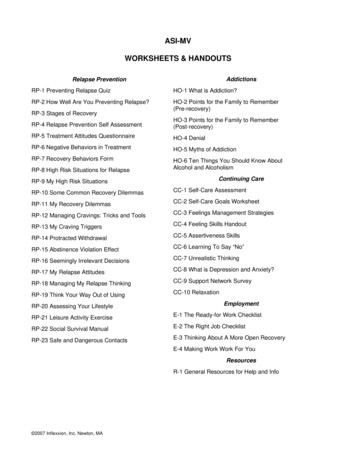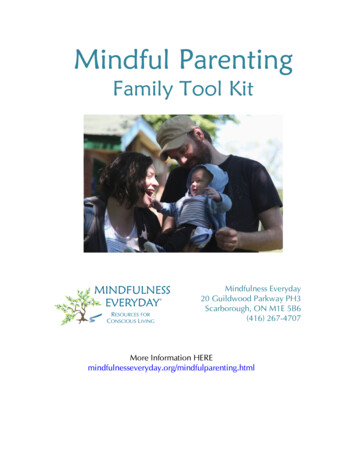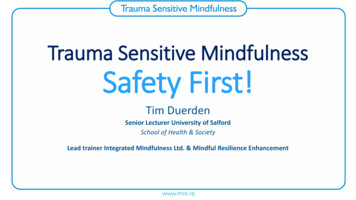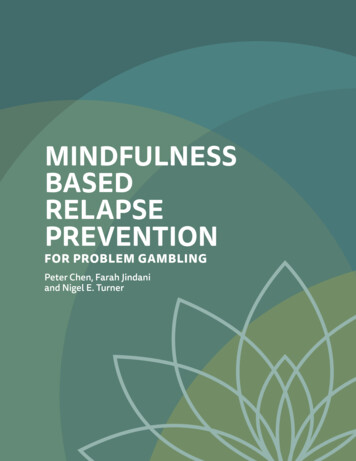
Transcription
MINDFULNESSBASEDRELAPSEPREVENTIONFOR PROBLEM GAMBLINGPeter Chen, Farah Jindaniand Nigel E. Turner
This work is licensed under aCreative Commons Attribution-NonCommercial 4.0 International License.02
Table of ContentsPrefaceivAcknowledgmentsvChapter 1An introduction to mindfulness01Chapter 2Mindfulness and diverse populations09Chapter 3Mindfulness and trauma16Chapter 4: Session 1Lesson plan for stepping out of automatic pilot25Handout 134
Chapter 5: Session 2Chapter 6: Session 3Chapter 7: Session 4Chapter 8: Session 5iiLesson plan for developing awareness andcoping with cravings/barriers to practice37Handout 145Handout 246Handout 348Lesson plan for bringing mindfulnessto everyday activities51Handout 158Handout 259Lesson plan for being mindful whenat risk to gamble61Handout 170Handout 271Handout 372Lesson plan for cultivating a differentrelationship to experience throughacceptance and clear seeing75Mindful movement/yoga practise81Handouts 186Handouts 287Poem: The Guest House88
Chapter 9: Session 6Chapter 10: Session 7Chapter 11: Session 8Lesson plan for seeing thoughtsas passing mental events91Handout 198Handout 299Lesson plan for being good to yourself101Handout 1107Handout 2108Lesson plan for maintaining practiceafter group ends111Handout 1115Poem: Paradox of noise116Chapter 12Concluding remarks and resources119Appendix 1Evaluation123Appendix 2Scientific research evaluating mindfulness125iii
PrefaceThis manual is intended for an 8-session mindfulness group, aimed at people experiencing problems with gambling who wish to add to their relapse prevention skills. The manual includes lesson plans for the 8 sessions for facilitators as well as handouts for clients.Chapter 1 of the manual is an introduction that provides some background aboutmindfulness and practical suggestions about the group facilitation.Chapter 2 discusses running mindfulness groups with diverse populations.Chapter 3 is a brief introduction to mindfulness and trauma and its suitabilitywith this population.Chapters 4 –11 present the 8 lesson plans in the order we usually hold them.Each lesson plan is followed by the relevant handouts.Chapter 12 presents concluding remarks and resources.Appendix 1 is an evaluation form.Appendix 2 provides a more detailed discussion of the scientific researchevaluating mindfulness.iv
AcknowledgmentsThe Buddha, Jack Kornfield, Jon Kabat-Zinn, Zindel V. Segal, Sarah Bowen, Neha Chawla, G.Alan Marlatt, Christopher Germer, Kristin Neff, John D. Teasdale, J. Mark G. Williams, SharonSalzberg, Pema Chodron, Ron Segal, Eckhart Tolle and Gil Fronsdal, to name a few.This manual has been greatly influenced by three previous mindfulness based programs;Mindfulness Based Stress Reduction by Jon Kabat-Zinn, Mindfulness Based Cognitive Therapy bySegal, Williams and Teasdale and especially Mindfulness Based Relapse Prevention by Bowen,Chawla and Marlatt.The development of this manual came out of a need to provide something more gambling specific to clients struggling with gambling problems. Practitioners in the Problem Gambling Treatment System were also requesting a gambling specific mindfulness manual that they could use,especially as interest in the application of mindfulness to gambling treatment had grown in thefield.Special mention should be given to the clients who participated in the mindfulness groups andwere willing to try something new and provide us with feedback. We learnt as much from themas they learnt from us.Funding for this project was based on a grant from the Gambling Research Exchange Ontario. The project was reviewed by the CAMH ethics review board and approved as Protocol#046/2014. The ideas expressed are those of the authors and do not necessarily reflect those ofeither Gambling Research Exchange Ontario, the Centre for Addiction and Mental Health, theProblem Gambling Institute of Ontario, or the University of Toronto.v
Mindfulness isessentially an awarenessand acceptance of yourown moment to momentexperience, includingthoughts, emotions andbody sensations.
Chapter 01An introductionto mindfulnessThe Mindfulness Based Relapse Prevention for Problem Gambling (MBRPPG) program is intended for clients attending problem gambling treatment in the action or maintenance stagesof change. Their gambling behaviour would need to be relatively stabilized and would need toinclude gambling goals of abstinence or controlled gambling. The development of this programwas based on the structure and format of Mindfulness Based Stress Reduction (MBSR) (Kabat-Zinn, 1990), Mindfulness Based Cognitive Therapy (MBCT) ( Segal, Williams, & Teasdale,2002, 2013) and Mindfulness Based Relapse Prevention (MBRP) (Bowen, Chawla, & Marlatt,2011), but has been tailored to the unique aspects of people experiencing problems with gambling.Clinicians working in addiction treatment programs have noted that their clients can benefitfrom exercise and relaxation techniques. Mindfulness meditation goes beyond relaxation byteaching clients how to be present in a non-judgemental way. It does this by teaching clientshow to step out of the usual habits of the busy mind, instead teaching them to observe and bewith their experience in any given moment. Segal (MBCT) ( Segal, Williams, & Teasdale, 2002,2013) refers to developing the “being mind” as opposed to the “doing mind.”The “doing” mind is the mode of mind that we are in most of the time. It helps us get things done
and problem solve. It is the logical mind. We access the “being” mind less often. It is the creativepart of the mind. The moment when we behold a beautiful sunset, and we become awestruckand have no words or thoughts, we might be in the “being” mode of mind. However, this mayonly last a split second and then we return to the “doing” mind, conceptualizing the sunset andreturning to our thoughts.The aim of a mindfulness approach is for clients to become aware of and accept, without judgement, their present moment experience and to learn to see thoughts and emotions as passingmental events. The goal is not to change anything about one’s experience, but, as defined byJon Kabat-Zinn (1990), to pay “attention in a particular way: on purpose, in the present moment,and non-judgementally” (as cited in Bowen et al., 2011, 46). In mindfulness practice, the client is encouraged to cultivate an attitude of curiosity, openness, friendliness, non-judgementalawareness, and acceptance of one’s present moment experience.What is mindfulness?Mindfulness is essentially an awareness and acceptance of your own moment-to-moment experience, including thoughts, emotions and body sensations. It does not mean suppression ofthoughts, emotions, or body sensations. It is non-judgemental awareness but also involves asense of detachment from thoughts, emotions and body sensations. That is, you are aware ofthe content of your thoughts, but do not identify with them or feel that you have to act uponthem, and can let them slide in and out of awareness. It is well known that you cannot willyourself to stop thinking about something. In fact, the opposite happens; trying not to thinkabout something makes it more difficult to unhook the thought. Rather than trying to suppressunwanted thoughts, the mindful person brings awareness to those thoughts and lets them be.This process is one of the key principles taught in a mindfulness class.Relation of problem gambling to mindfulness-based approachesRelapse prevention from a Cognitive Behavioral perspective involves helping clients developgreater awareness of individual triggers and urges to gamble. Mindfulness practice also helpsclients develop greater awareness of triggers and urges, as well as develop a different relationship to their experience by adopting an attitude of curiosity and non-judgemental awareness.According to Toneatto, Vettese, and Nguyen (2007):[d]istinguishing mental events from the responses to them provides a choice to the gamblerregarding how best to respond, rather than react, to gambling related cognition. It is arguedthat improving gambler’s mindfulness can help them overcome the erroneous beliefs andautomatic behaviours associated with problem gambling. Learning to relate differently togambling cognitions may be as important as, if not more important than, challenging thespecific content of the thoughts (Toneatto et al., 2007, 94).Through mindfulness meditation practice, clients become aware of their urges but do not feelcompelled to act on them. The key is learning to recognize the impermanence of experiencesand understanding urges as passing mental events that do not have to be acted upon or fought.2
Moderate and severe gambling problems affect approximately2.5 % of the adult population in Ontario.We believe this is particularly important for problem gambling because of the critical role oferroneous beliefs about gambling games and the tendency of gamblers to switch into autopilotwhile gambling. The mindful approach to erroneous cognitions brings awareness to the automatic nature of these thoughts. Gamblers often do know that these thoughts are inaccurate, butin the excitement of gambling, they go into autopilot. We believe that mindfulness may be ameans of breaking that cycle by helping the client avoid autopilot.In recent years there has been a growing literature on the relationship between mindfulnessand problem gambling (see de Lisle et al., 2012; Shonin et al., 2013b). According to de Lisle et al.(2012) the literature indicates that there is an inverse relationship between dispositional mindfulness and psychological distress, and this may be mediated by a number of factors includingemotional, cognitive, and behavioural flexibility. For example, Lakey et al. (2007) found a significant negative correlation between gambling problems and mindfulness amongst undergraduate students. For more information on research into mindfulness, see Appendix 2.MBRPPG groups are experiential in nature. The best way to learn mindfulness is by the directexperience of the practice itself. The process of teaching mindfulness is different from othergroups, where the theory and concepts are first discussed and then followed by practice of theskill to be learned. In contrast, mindfulness groups usually start with a mindfulness practicesuch as the body scan, sitting meditation, mindful eating, and follow with a discussion—calledthe inquiry.InquiryFollowing every mindfulness practice, facilitators ask group members what they noticed duringthe practice. This serves to enhance the learning of the practice itself and emphasize the directexperience of the practice. Inquiry is different from other treatment group discussions thatcentre on the analysis and interpretation of events. Inquiry is about what is observed duringthe mindfulness practice, focusing on body sensations, thoughts and emotions in a curiousand non-judgemental manner.FacilitatorsMBRPPG facilitators need to have expertise in problem gambling counseling, including cognitive-behavioral relapse prevention strategies. Most importantly, they should have specifictraining in leading mindfulness groups (such as MBSR or MBCT group facilitation training)and a personal mindfulness practice. It is of utmost importance that facilitators have their ownmindfulness practice. Facilitators can only embody and model mindfulness if they cultivatetheir own mindfulness. Returning to the bicycle example, it is difficult to teach someone to ridea bicycle if you cannot ride a bicycle yourself!Problem gamblingModerate and severe gambling problems affect approximately 2.5% of the adult population inOntario (Williams & Volberg 2013). Or about 332,000 adults in the province of Ontario. People with problems related to gambling may also have other co-occurring mental health issues,3
such as depression and anxiety, and other behavioral challenges, such as substance use, internet overuse, over eating, compulsive shopping or unhealthy relationships (see Malat et al., 2010).According to Malat et al. (2010), the most common behavioral addictions in his problem gambling client population are over eating, unhealthy relationships, and compulsive shopping.Treatment of problem gamblingIn Ontario, treatment for people with problems related to gambling was first implemented in1995, in response to the opening of the first commercial casino in Windsor. Knowledge aboutwhat constitutes effective treatment has been growing ever since. There is no one approachthat suits everyone, as each individual has differing needs. However, an extensive knowledgebase on what works has been developed, based on extensive clinical experience and excellentresearch. Over the past three decades, mindfulness has been increasingly integrated into a variety of addictions and mental health programs. The mindfulness groups have been offered atthe Problem Gambling Institute of Ontario (PGIO) as a regular part of programming since 2010.Treatment services, for the most part, have adopted an eclectic and holistic approach includinga bio-psycho-social-spiritual model employing different methods for different clients. One ofthe reasons for the introduction of mindfulness groups is because problem gambling clinicians felt that their clients could benefit from learning ways to be more aware of their thoughtswhile unhooking from them and not giving in to them. This is especially true given problemgamblers’ tendency to hold erroneous beliefs (Toneatto et al., 1997) and to engage in automaticthinking before, during, and after gambling (Jacobs, 1988; Gupta & Derevensky, 1998). People with gambling problems tend to have more cognitive and belief issues to deal with, buton the other hand have fewer physiological withdrawal issues. They also tend to be higherfunctioning and less likely to show impairment in their cognitive abilities compared to substance use clients because gambling does not harm the brain. This means, on the one hand,that self-awareness may be easier compared to other addiction clients, but on the other hand,they may also be very good at denial and rationalization. For example, gamblers will come upwith systems such as doubling after a loss that they believe will allow them to beat the odds (seeTurner, 1998) and are good at finding reasons to justify their gambling, even when the systemsfail (see Toneatto et al., 1997).Relapse preventionA characteristic of problem gambling is recurring relapse of the gambling behaviour. The purpose of the mindfulness group is to improve a client’s chance of preventing further gamblingby integrating mindfulness with relapse prevention strategies. In the group, clients will learnskills to help them manage their urges and cravings to gamble. They will learn these skills ina group with other people who are also experiencing gambling problems. The group will meetfor eight weekly 2-hour sessions to learn ways of dealing with the thoughts and feelings thatare part of the urges and temptations to gamble. They will also have opportunities to share theirexperiences with other group members and ask questions about the mindfulness practice.4
Practice is the keyIt is important for clients to know that learning the skill of mindfulness is going to take effortand practice. This approach depends a lot on the client’s willingness to do home practice between class meetings. Home practice involves tasks such as listening to the recorded meditations that will be provided, and bringing mindfulness to daily routine activities, such as eating,taking a shower, cooking, walking, brushing your teeth and so on. Many barriers to practicewill come up, and these will be discussed in the group. However, the commitment to spendtime on home practice is an essential part of the group.Keeping up the practice on a regular basis over time is important. Similar to all skills, clientswill only see results after repeated practice. Persistence in the face of gambling losses is a hallmark of a gambling problem, and this same attribute can help problem gamblers succeed inmeditation.Gambling habits took a long time to develop and so will these new habits, but they are possibleto learn. Encourage your clients not to keep up the practice by committing time and effort, andencourage them. Becoming more self-aware is not difficult, but it does take motivation andpractice.Turning toward rather than avoidingThe mindfulness practices that clients will learn in the group and at home will enable them tobe more fully aware and present in each moment of their life. They will learn to turn towardsdifficulties in their life rather than away from them, like they may have done in the past. Formany people with gambling problems, what motivates them to gamble is to escape or avoid reality, to dream about the big win, or to zone out and not think of anything. But using gamblingas an escape is problematic; eventually it is gambling that they have to escape from. In contrast,mindfulness means accepting the good and the bad in our lives and not clinging to what wewant and pushing away what we don’t want. In the long run, this approach is more effectiveand liberating than gambling could ever be, and free of the financial issues that result fromproblem gambling.Being more present and aware in one’s life and able to “see” more clearly is central to preventing further gambling problems, and to making more skillful decisions that are grounded in thepresent. In the group sessions, clients will learn to remain open to and face difficulties, and besupported by the instructor and the other group members.5
What others have learned from the groupHere are some things that participants in past groups have reported:(Chen, Jindani, Perry, & Turner, 2014)Now I can recognize what [s] happeninginternally and separate myself fromwhat I’m thinking.I have become more aware of the presentmoment. I have become more mindfuland conscious about the present moment,learning to take things one step at a time.My brain is very busy but in thiscourse, I learned how to stay onNOW, in this moment.I had a bit of a crisis while I took thiscourse and it got me through bypracticing mindfulness and journaling.Mindfulness/awareness of warningsigns and triggers is my main tool tonot returning to coping via gambling.Much better listener and not affectedby small things. Conflicts are lesssevere when you don’t react right away.Learn how to calm down by usingthe 3 minute breathing meditation.Stop and think before I do any harmor damage to myself.I learned to discipline myself better.To be able to control going into auto pilot.Learned how I sometimes get ridof bad thinking and be relaxed.Mental and physical healthhas improved greatly.Always brightened my mood.Feel more positive.I have more patience and amaware of my heartbeat.Learnt about taking your time onsomething without stressing yourself.Learn how to calm down—Less anxiety.During the group, clients will find that there are many different ways to be mindful. By tryingall the mindfulness practices, they discover the ones that are most useful for them. The weeklygroup also provides the opportunity to practice being kinder and gentler to yourself.6
7
Mindfulness practiceis based on learningto pause and becomeattuned to your ownmind and body anddevelop enhancedawareness.
Chapter 02Mindfulness anddiverse populationsScientific evidence demonstrates that mindfulness-based interventions are beneficial for numerous physical and mental health concerns, including but not limited to: cancer, chronic pain,eating disorders, stress reduction, depression, anxiety, and, trauma (Amaro et al., 2014; Dimidjian et al., 2014; Karyadi et al., 2014; Liehr & Diaz, 2010). Mindfulness treatments have beeneffective for specialized and often marginalized populations, including: women with substanceuse disorders, youth, ethno-racial populations, perinatal depression, traumatized women, gamblers, and, older adults (Amaro et al., 2014; Dimidjian et al., 2014; Gallego et al., 2013 Chen et al.,2014).As the empirical literature suggests, the potential impacts of mindfulness are vast. However,there are a number of issues that may present when implementing this approach with individuals from underserved and underrepresented backgrounds (e.g., marginalized racial groups,low socioeconomic groups, persons with disabilities, etc.). For instance, there are a number ofsystemic barriers in the environment that can limit opportunities for employment, heightenstressors and impact oppression (Sobczak & West, 2013). Mindfulness strategies offer an opportunity to identify some of the emotions associated with the various oppressions and strugglesin your life. This section discusses the use of mindfulness as a tool for working with individualsfrom diverse groups. The relationship between gambling and mindfulness is also illustrated.
An overarching theme of the existing research and practice base is that mindfulness is holisticin nature—supporting the mind, body and spirit. Mindfulness practice is based on learningto pause and become attuned to your own mind and body and develop enhanced awareness.When you can learn to focus and attune your attention in the present moment, it is possible tobecome aware and open to novel experiences, multiple perspectives, develop a greater sense ofcompassion for self and others, lending to a state of acceptance (Langer, 1990). Essentially, youcan learn to have a more positive relationship with your emotions and thoughts.While the benefits of mindfulness in a person’s life over the long-term are predominantly positive, some people may struggle with imparting mindfulness practices into their life. Stressesrelated to racism may impact how people may perceive the practices (Amaro, 2014). As an example, the avoidance of emotions may have been a protective factor for a racialized womanstruggling with employment and housing. Having experienced numerous instances of racismin early life, she may engage in gambling as an outlet for dealing with emotions. She may ormay not be aware of her gambling related triggers. Despite her resilience in maintaining steadyemployment and raising healthy and successful children, her gambling may have increased toa point that is no longer healthy. This woman might now label herself as a gambler and feel asense of guilt and regret regarding her gambling behaviours. Such feelings can lead to a senseof powerlessness.Mindfulness offers an opportunity to help individuals to become fully aware of and engagewith their emotions. Through mindful practice, you can identify values that are important toyourself and become aware of what would lead to living a meaningful life. Gambling treatmentcan raise numerous emotions and challenges related to health, finances, employment, and relationships. Numerous other external or internal stresses may coexist. Encouraging clients to“sit and be silent” with their feelings can be overwhelming, challenging or viewed as a sillyexercise.Acknowledging that gambling clients may be experiencing numerous barriers and challenges,it may be valuable for a clinician who is introducing mindfulness to clients to explain the waysin which the avoidance of distressing emotions may be related to their gambling related feelings and behaviours. The clinician must also acknowledge the emotional pain and discomfortthat may arise when painful emotions arise in the mindfulness process (Sobczak & West, 2013).Validation of client experiences and an encouragement to continue with mindfulness can allow emotions to surface for further exploration, allowing acceptance of past challenges and astance of living in the present. This process can help lead to greater self-esteem, self-regulationand perceptions of self in relation to others (Chen et al., 2014).For people who are experiencing gambling related challenges, treatment using a mindfulnessbased approach offers the potential to be in touch with emotions and grapple with what is important in terms of living a valued, meaningful and purposeful life. In exploring what is important, people who have been struggling with gambling have the opportunity to become intouch with their gambling-related triggers, relationships, values regarding money and howthey wish to live life when gambling is no longer the central aspect of their life. An importantstep in this process is identifying their values at this point in life (Sobczak & West, 2013). Forinstance, for a client who has been gambling for the last five years and is now coming to termswith the financial losses and debts, they may experience great guilt, anger, anxiety and frus-10
Eckhart Tolle defined spirituality as not having to do with a belief,but about one’s relationship with the present moment.tration with their prior gambling behaviours. Rather than these emotions being triggers to further gambling, mindfulness can promote the acceptance of challenges in the face of adversity(Sobczak & West, 2013).Aspects of mindfulness modalities can be practiced at any time, making this approach empowering for clients. As clients attend to their own emotions and sensations, they are encouraged toreconnect to aspects of their lives that are valuable and to consider what is meaningful. Spaceto consider your own values, beliefs and emotions and acting on what is meaningful can be anempowering process for individuals from diverse backgrounds (Sobczak & West, 2013).A challenge that may arise in the presentation of mindfulness as a treatment option is the concern that mindfulness is religious. Given its origin in Buddhism, some people may feel it clashes with their own beliefs. According to Dr. Eifring at the University of Oslo, “meditation hasbeen performed for several thousand years, and appears in all the major religions” (Universityof Oslo, 2014, May 13) and is also an integral part of ritual trances used in shamanistic cultures (Basilov, 1990). There are “numerous forms of meditation” (University of Oslo, 2014, May13), far more then we are familiar with today. A major difference between Western and Asiaticmeditation is that in the West, meditation focuses on the individual’s relationship with God(s)and includes prayer and the contemplation of specific religious passages. Western meditationtends to be about the content of contemplation, whereas in the Asian tradition, meditation ismore about the techniques (e.g., breathing, yoga stretches). Since the 1950s, meditation hasbecome less about the content and more about the technique (University of Oslo, 2014, May 13).Nonetheless, Asian forms of meditation may be controversial to some people from Western religious traditions, perhaps because they view meditation as tied to faith. It may be valuable forclinicians to provide psychoeducation about mindfulness as a therapeutic tool and its efficacyregardless of spirituality (Sobczak & West, 2013). If the client already has a religious or spiritualpractice, aspects of mindfulness might be integrated into current practices. Sobczak & West(2013) also suggest that it would also be valuable for the clinician to explore with the clientstrategies that they have implemented in the past to overcome challenging situations, and theextent to which they found these strategies helpful. Mindfulness can be offered as one of several strategies that clients may find valuable. To note, most religious traditions contain some sortof contemplative practice where one cultivates stillness and presence (University of Oslo, 2014,May 13), similar to mindfulness. Prayer, for example, can be viewed as a type of meditation.Eckhart Tolle defined spirituality as not having to do with a belief, but about one’s relationshipwith the present moment. With an emphasis on technique rather than content, anyone can obtain a deeper understanding of themselves and learn to live in the moment using meditation,without accepting any Buddhist religious ideas.Mindfulness is about learning to get in touch with your inner world, cultivating greater self-awareness and insight. In this way, irrespective of ethnic or cultural backgrounds, learning mindfulness does not impose any particular belief or approach on the practitioner, but simply helpsthem be present in a curious and non-judgemental manner.In an embodied way, people can learn to become aware of their triggers to gambling and learntools for processing and sitting with those reactions. Mindfulness is synonymous with embodied self-reflection, and emotions are at the root of self-reflection. By learning to become aware11
of emotions and physical attributes associated with behavior, mindfulness teaches skills forcompassion toward self and others.As a skill-based treatment intervention, people experiencing problems with gambling canlearn through mindfulness practice how to become aware of their physiological and emotional experiences in a manner that allows them to become an observer of their experiences. Inthis empowering way, those who diligently practice mindfulness, irrespective of diverse backgrounds, no longer identify themselves as a “label” but can learn to become aware and accepttheir personalized issues of diversity and addiction. This occurs through detachment but notdissociation from their experience, through non-judgemental awareness. In fact it’s the opposite of dissociation. Dissociation is a loss of awareness, going into a dream world to escape it;meditation is an increased awareness while learning how to relax, accept, be non-reactive andnon-judgemental so that they don’t need to escape.Self-acceptance of identity, values and sense of meaning can lend to a fuller understanding andappreciation of how experience and perspective impacts emotions and behaviours. Irrespective of differences, this can be an empowering experience for anyone. Honouring and acceptingone’s own experience translates into a greater sense of awareness towards others. Awarenessthrough mindfulness practice offers the opportunity for self-development in a healthy
mindfulness and practical suggestions about the group facilitation. Chapter 2 discusses running mindfulness groups with diverse populations. Chapter 3 is a brief introduction to mindfulness and trauma and its suitability with this population. Chapters 4-11 present the 8 lesson plans in the order we usually hold them.
